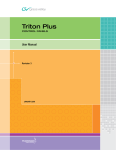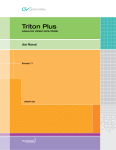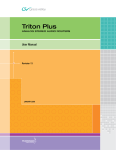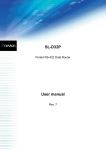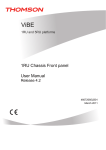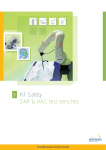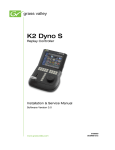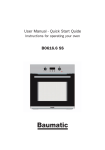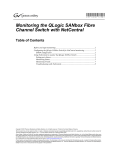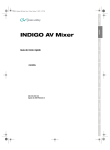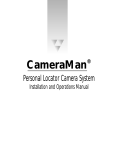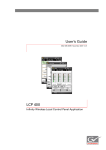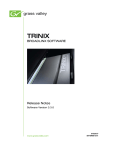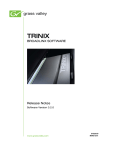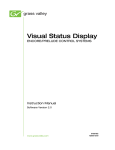Download Triton Plus Ported RS-422 Data Routers Product Overview
Transcript
Triton Plus PORTED RS-422 DATA ROUTER User Manual Revision 5 JANUARY 2009 Affiliate with the N.V. KEMA in The Netherlands CERTIFICATE Certificate Number: 510040.001 The Quality System of: Grass Valley, Inc. 400 Providence Mine Road Nevada City, CA 95945 United States 15655 SW Greystone Ct. Beaverton, OR 97006 United States 10 Presidential Way rd 3 Floor, Suite 300 Woburn, MA 01801 United States Nederland B.V. 4800 RP BREDA The Netherlands Weiterstadt, Germany Brunnenweg 9 D-64331 Weiterstadt Germany Rennes, France Rue du Clos Courtel Cesson-Sevigne, Cedex France Technopole Brest Iroise CS 73808 29238 Brest Cedex 3 France 17 rue du Petit Albi-BP 8244 95801 Cergy Pontoise Cergy, France 2300 South Decker Lake Blvd. Salt Lake City, UT 84119 United States 7140 Baymeadows Way Suite 101 Jacksonville, FL 32256 United States Including its implementation, meets the requirements of the standard: ISO 9001:2000 Scope: The design, manufacture and support of video hardware and software products and related systems. This Certificate is valid until: This Certificate is valid as of: Certified for the first time: June 14, 2009 August 30, 2006 June 14, 2000 H. Pierre Sallé President KEMA-Registered Quality The method of operation for quality certification is defined in the KEMA General Terms And Conditions For Quality And Environmental Management Systems Certifications. Integral publication of this certificate is allowed. KEMA-Registered Quality, Inc. 4377 County Line Road Chalfont, PA 18914 Ph: (215)997-4519 Fax: (215)997-3809 CRT 001 073004 Accredited By: ANAB Triton Plus PORTED RS-422 DATA ROUTER User Manual Revision 5 JANUARY 2009 Contacting Grass Valley International France +800 8080 2020 or +33 1 48 25 20 20 United States/Canada Support Centers 24 x 7 +800 8080 2020 or +33 1 48 25 20 20 24 x 7 Asia +1 800 547 8949 or +1 530 478 4148 Hong Kong, Taiwan, Korea, Macau: +852 2531 3058 Indian Subcontinent: +91 22 24933476 Southeast Asia/Malaysia: +603 7805 3884 Southeast Asia/Singapore: +65 6379 1313 China: +861 0660 159 450 Japan: +81 3 5484 6868 Local Support Australia and New Zealand: +61 1300 721 495 Central/South America: +55 11 5509 3443 Centers (available Middle East: +971 4 299 64 40 Near East and Africa: +800 8080 2020 or +33 1 48 25 20 20 during normal Belarus, Russia, Tadzikistan, Ukraine, Uzbekistan: +7 095 2580924 225 Switzerland: +41 1 487 80 02 business hours) S. Europe/Italy-Roma: +39 06 87 20 35 28 -Milan: +39 02 48 41 46 58 S. Europe/Spain: +34 91 512 03 50 Europe Benelux/Belgium: +32 (0) 2 334 90 30 Benelux/Netherlands: +31 (0) 35 62 38 42 1 N. Europe: +45 45 96 88 70 Germany, Austria, Eastern Europe: +49 6150 104 444 UK, Ireland, Israel: +44 118 923 0499 Copyright © Thomson. All rights reserved. This product may be covered by one or more U.S. and foreign patents. Grass Valley Web Site The www.thomsongrassvalley.com web site offers the following: Online User Documentation — Current versions of product catalogs, brochures, data sheets, ordering guides, planning guides, manuals, and release notes in .pdf format can be downloaded. FAQ Database — Solutions to problems and troubleshooting efforts can be found by searching our Frequently Asked Questions (FAQ) database. Software Downloads — Download software updates, drivers, and patches. 4 Triton Plus - Ported RS-422 Data - User Manual Contents Triton Plus Ported RS-422 Data Routers . . . . . . . . . . . . . . . . . . . . . . . . . . . . . . . . 7 Product Overview . . . . . . . . . . . . . . . . . . . . . . . . . . . . . . . . . . . . . . . . . . . . . . . . . . . . . . 7 Connection Details . . . . . . . . . . . . . . . . . . . . . . . . . . . . . . . . . . . . . . . . . . . . . . . . . . . . . 8 Power Supply Pinouts . . . . . . . . . . . . . . . . . . . . . . . . . . . . . . . . . . . . . . . . . . . . . . . . 9 Configuration. . . . . . . . . . . . . . . . . . . . . . . . . . . . . . . . . . . . . . . . . . . . . . . . . . . . . . . . . 10 Configuration Switches. . . . . . . . . . . . . . . . . . . . . . . . . . . . . . . . . . . . . . . . . . . . . 10 Audio/Video Mode. . . . . . . . . . . . . . . . . . . . . . . . . . . . . . . . . . . . . . . . . . . . . . . . 11 D1616 Mode . . . . . . . . . . . . . . . . . . . . . . . . . . . . . . . . . . . . . . . . . . . . . . . . . . . . . . 11 Power Alarm. . . . . . . . . . . . . . . . . . . . . . . . . . . . . . . . . . . . . . . . . . . . . . . . . . . . . . 11 Power Up Mode . . . . . . . . . . . . . . . . . . . . . . . . . . . . . . . . . . . . . . . . . . . . . . . . . . . 12 Router Orientation . . . . . . . . . . . . . . . . . . . . . . . . . . . . . . . . . . . . . . . . . . . . . . . . . 12 LED Status . . . . . . . . . . . . . . . . . . . . . . . . . . . . . . . . . . . . . . . . . . . . . . . . . . . . . . . . . . . 14 Alarm States . . . . . . . . . . . . . . . . . . . . . . . . . . . . . . . . . . . . . . . . . . . . . . . . . . . . . . . . 14 Router Communication . . . . . . . . . . . . . . . . . . . . . . . . . . . . . . . . . . . . . . . . . . . . . . . . 15 Serial Connection. . . . . . . . . . . . . . . . . . . . . . . . . . . . . . . . . . . . . . . . . . . . . . . . . . . . 15 Maximum Cable Length (RS-232) . . . . . . . . . . . . . . . . . . . . . . . . . . . . . . . . . . . . 16 NCB Connection . . . . . . . . . . . . . . . . . . . . . . . . . . . . . . . . . . . . . . . . . . . . . . . . . . . . 16 Connecting Control Panels . . . . . . . . . . . . . . . . . . . . . . . . . . . . . . . . . . . . . . . . . . 16 Pinout and Cable Type . . . . . . . . . . . . . . . . . . . . . . . . . . . . . . . . . . . . . . . . . . . . . 16 Termination Plug . . . . . . . . . . . . . . . . . . . . . . . . . . . . . . . . . . . . . . . . . . . . . . . . . . 17 Control Bus Structure . . . . . . . . . . . . . . . . . . . . . . . . . . . . . . . . . . . . . . . . . . . . . . 18 Maximum Distance Between NCB Devices . . . . . . . . . . . . . . . . . . . . . . . . . . . . 18 Connecting RS-422 Signal Cables To Data Router . . . . . . . . . . . . . . . . . . . . . . . . 19 Applications . . . . . . . . . . . . . . . . . . . . . . . . . . . . . . . . . . . . . . . . . . . . . . . . . . . . . . . . 20 Dynamic . . . . . . . . . . . . . . . . . . . . . . . . . . . . . . . . . . . . . . . . . . . . . . . . . . . . . . . . . 20 Fixed. . . . . . . . . . . . . . . . . . . . . . . . . . . . . . . . . . . . . . . . . . . . . . . . . . . . . . . . . . . . . 20 Specifications . . . . . . . . . . . . . . . . . . . . . . . . . . . . . . . . . . . . . . . . . . . . . . . . . . . . . . . . . 21 Triton Plus - Ported RS-422 Data - User Manual 5 Contents 6 Triton Plus - Ported RS-422 Data - User Manual Triton Plus Ported RS-422 Data Routers Product Overview Professional broadcast installations often include a number of tape recorders and other devices that require RS-422 machine control for remote operation. To meet these requirements, Thomson Grass Valley introduces the Triton Plus TPS-D32P Ported Data Router. Complex installations, cable cost and system design is kept at a minimum. Where user friendliness and operational flexibility is appreciated, the TPS-D32P will fit in perfectly. The Ported Data Routers are bi-directional ports rather than XY. A traditional 32x32 router will have a total of 64 connectors (32 in/32 out). A ported 32 Router will have a maximum of 32 connectors, all configurable to be operated either as Controller or Device. In the TPS-D32P Ported Data Router the terms Controller and Device are used instead of In/Out, Source/Destination. I.e. a Ported Data Router Controller can be both signal Source or Destination. All ports are coupled according to SMPTE-207M machine control standard. Triton Plus - Ported RS-422 Data - User Manual 7 Connection Details Connection Details Available ports and connectors at the back of the Triton Plus TPS-D32P data router are shown in Figure 1 and listed below: • RS-422 connectors: 32 device connectors • RS-232 Port: RS-232 for external control • Power Connectors • • A: ±15VDC power input • B: ±15VDC power input, redundant supply NCB • IN: Network Control Bus input • OUT: Network Control Bus output • Configuration switches: DIP switches for configuration settings • Ethernet: Not used at this time. Figure 1. Triton Plus TPS-D32P Ports and Connectors 8 Triton Plus - Ported RS-422 Data - User Manual Connection Details Power Supply Pinouts The DB9 power pinouts for Triton Plus routers and control panels are given in Table 1. Table 1. Power Supply Pinouts Pin Number Description 1 GND 2 Not Connected 3 Not Connected 4 +15 VDC 5 Not Connected 6 Not Connected 7 Not Connected 8 -15 VDC 9 Not Connected Triton Plus - Ported RS-422 Data - User Manual 9 Configuration Configuration It is possible to use the router out-of-the-box. Changes to the factory settings can be set with the DIP switches found in the back of the router. As factory setting, the TPS-D32P is shipped with Dynamic ports. This means every port can be controller or device depending on the connected equipment. Configuration Switches You will find 2x10 DIP switches on the backplane of the router (see Figure 1 on page 8). Switches 1 - 4 set the router Level and the Physical Address for this unit. By setting routers and Control Panels on same level, routers can be controlled as one, i.e. Audio-follow-Video. Panels in a NCB loop must be configured to the same level as the router(s). The Levels/Physical Addresses can be set according to the following pattern given in Table 2. The default level is 1. Table 2. Levels and Physical Addresses Switch Patterns SW 1 10 SW 2 SW 3 SW 4 Level Physical Address Off Off Off Off 1 0 Off Off Off On 2 1 Off Off On Off 3 2 Off Off On On 4 3 Off On Off Off 5 4 Off On Off On 6 5 Off On On Off 7 6 Off On On On 8 7 On Off Off Off 9 8 On Off Off On 10 9 On Off On Off 11 10 On Off On On 12 11 On On Off Off 13 12 On On Off On 14 13 On On On Off 15 14 On On On On 16 15 Triton Plus - Ported RS-422 Data - User Manual Configuration Audio/Video Mode The TPS-D32P router can be assigned to either the video level or the audio level of a router system, selectable with switch SW 5 on the configuration switch. If you’re using the Data Router in an Audio-follow-video setting, the Data Router can be set as Video, giving an Audio-follow-Data function. Breakaway is also possible with this set-up. Table 3 gives the settings for SW 5. The Default mode is Off. Table 3. Audio/Video Modes – SW 5 SW 5 Router Mode Off Controlled as Audio On Controlled as Video D1616 Mode If The TPS-D32P Ported Data Router is to be configured as a D1616 router, this DIP switch (SW 6) must be ON. The TPS-D32P will then be configured as 16 inputs (1-16) and 16 outputs (17-32) and will be identical with the existing Triton Plus D1616 Data Router. Table 3 gives the settings for SW 6. The Default mode is Off. Table 4. D1616 Mode – SW 6 SW 6 D1616 Mode Off TPS-D32P mode On D1616 mode Power Alarm The Power Alarm is set with DIP switch SW 7. When using a redundant power supply, the power alarm should be ON. If only one power supply is connected, this DIP must be off. Settings are shown in Table 5. The default mode is Off. The TPS-D32P will give an alarm and the front LED will blink red when one of the power supplies connected fails. Table 5. Power Alarm Settings – SW 7 SW 7 Power Alarm Off Disables power alarms On Enables power alarms Triton Plus - Ported RS-422 Data - User Manual 11 Configuration Power Up Mode Switch SW 8 on the configuration switch defines the power up mode. The TPS-D32P router provides two modes for powering up the system: • Mode 1 switches all ports as disconnected. • Mode 2 switches all ports according to the latest setting buffered in the router’s processor system. Settings for SW 8 are given in Table 6. The default mode is Off. Table 6. Power up Settings – SW 8 SW 8 Power Up Mode Off Mode 2 On Mode 1 Router Orientation Crosspoint commands in control protocols are using source and destination when controlling routers. This must be mapped to ports in the router. When controlling RS-422, every port is bi-directional and includes both a source and a destination. The mapping is different in D1616 mode and TPS-D32P mode. Router Orientation in TPS-D32P Mode By default, the router is destination oriented (SW 9 DIP is OFF). A bi-directional connection is made between the two ports. If both ports are configured as dynamic, the port referred as source will be used as a controller and the port referred as destination will be used as a device. When the router is source oriented (SW 9 DIP is ON) the mapping is different. If both ports are configured as dynamic, the port referred as source will be used as a device and the port referred as destination will be used as a controller. This makes it possible to use a single-bus panel to select one-of-several machines to control from a single location. Router Orientation in D1616 Mode In D1616 mode all ports are fixed, port 1-16 as controllers and port 17-32 as devices. The control system will see the router as a 16x16 matrix. When the router is destination oriented, destinations 1-16 are mapped to ports 17-32 while sources 1-16 are mapped to ports 1-16. When the router is source oriented, destinations 1-16 are mapped to ports 1-16 while sources 1-16 are mapped to ports 1-16. As in TPS-D32P mode this makes it possible to use a single-bus panel to select one-of-several machines to control from a single location. 12 Triton Plus - Ported RS-422 Data - User Manual Configuration Switch SW 9 on the configuration switch defines the router orientation as shown in Table 7. The default setting is Off. Table 7. Router Orientation Settings – SW 9 SW 9 D1616 Mode Off Destination oriented On Source oriented Future Use Switches 10 -17 are currently not in use. Ext Address Switches 18 -20 are currently not in use. Triton Plus - Ported RS-422 Data - User Manual 13 LED Status LED Status The LED located at the front of the router indicates the status of the router. At start-up, the LED will alternate between red (R) and green (G) every 500ms for about two seconds. After the start-up sequence the LED will indicate the Alarm state of the router. Alarm States The LED can either be red (R), green (G), or have no light (N). The LED state is described in Table 8 below with twenty letters, each representing 100ms, which totals an alarm sequence of two seconds. The X indicates that the LED keeps the color it has the moment the alarm sequence begins (green or no light). Table 8. LED Alarm States Description LED State Continuous Green Light GGGGG GGGGG GGGGG GGGGG 14 Alarm Comment No Alarm Status OK Long Red Blinking RRRRR NNNNN RRRRR NNNNN Power is too low One Short Red Blink RXXXX XXXXX XXXXX XXXXX Power A failed Two Short Red Blinks XXXXX XXXXX RXRXX XXXXX Power B failed Only active if power alarm DIP is set. Triton Plus - Ported RS-422 Data - User Manual Router Communication Router Communication You gain access to the router for communication purposes by connecting the router’s serial port to your computer. Serial Connection Connection can by made trough the serial port(s) of the router; see also Connection Details on page 8 for connection details. The communication parameters are configurable. Please refer to the protocol documentation of the appropriate communication/control protocol. Example: The protocol parameters of the Triton Plus Compact routers are as follows: • Bit rate 19200 bit/s • Data bits 8 bits • Stop bits 1 • Parity: No parity For further detail concerning this protocol, please refer to the following manual: Compact Router Control Protocol. The DB9 female connector for the serial port(s) of the router has the following pinout (Table 9): Table 9. Serial Connection Pinout Note Pin # RS-232 Mode 1 Not in use 2 Tx 3 Rx 4 Not in use 5 GND 6 GND 7 RTS 8 CTS 9 Do Not Connect! If the standard RS-232 cable specification (DCE) is followed: A cable with Male+Male or Female+Female connectors at the cable ends is used for Rx/Tx crossed connection. A cable with Male+Female connectors at the cable ends is used for a straight through connection. Triton Plus - Ported RS-422 Data - User Manual 15 Router Communication Maximum Cable Length (RS-232) IEEE has specified the maximum cable length for an RS-232 connection to 15 meters. Longer distances can be installed depending on the environmental conditions of the installation site. It is the responsibility of the installer/user to secure a proper installation of the RS-232 connection. NCB Connection Via the Network Control Bus system, several routers and control panels can be interconnected. Up to 16 levels of routers, or combinations of routers, can be controlled. The NCB system and all RS-232 ports interchange the system status. This means that any control system, either from Grass Valley, or from a third party manufacturer, connected to any RS-232 port in the NCB loop, will have access to all communication data on the bus. Connecting Control Panels To get a control panel working with a specific router, configure the control panel to the same level as the router. Several panels can be configured to control the same router. Panels can also be connected to a router via the RS-232 interface. Please refer to your control panel manual for installation. Pinout and Cable Type Triton Plus routers and Control Panels use RJ45 connectors for the Network Control Bus ports. The following pinout shown in Table 10 is used: Table 10. RJ45 Connector Pinouts 16 Pin # Description 1 Not Connected 2 Not Connected 3 Data (retour) 4 Data 5 Data 6 Data (retour) 7 Not Connected 8 Not Connected Illustration Triton Plus - Ported RS-422 Data - User Manual Router Communication The following connection example (Figure 2) shows connection of four Triton Plus devices with RJ45 connectors and bus termination: Figure 2. Four Devices Connected Together Using RJ45 Note Each device at the end of the chain has a termination plug, indicated with the letter T. This termination plug must be inserted in the correct connection port. If not, no NCB communication is possible. Termination Plug The termination plug that is mentioned in the previous section is necessary when you want to avoid closing the loop with a (long) cable. The termination plug is a standard RJ45 plug with the following internal wiring shown in Figure 3. Figure 3. RJ45 Termination Plug Wiring Pin 3 is connected to Pin 4 Triton Plus - Ported RS-422 Data - User Manual Pin 5 is connected to Pin 6 17 Router Communication Control Bus Structure The Network Control Bus structure follows the standard MIDI bus definition. The NCB is defined as a closed chain of units. This means that the NCB OUT of the last unit must be connected to the NCB IN of the first unit in the NCB chain. To avoid problems with the control of Triton Plus units the installer/user has to assure that the bus structure is installed according to this definition. Note The total number of Triton Plus devices in an NCB chain is limited to 50. Maximum Distance Between NCB Devices The standard MIDI definition allows a maximum cable length of 200-250 meters between two devices. Longer distances can be made with MIDI repeater units. To avoid grounding problems all NCB ports have opto-coupled inputs. 18 Triton Plus - Ported RS-422 Data - User Manual Router Communication Connecting RS-422 Signal Cables To Data Router All router ports on the TPS-D32P are coupled in accordance to the SMPTE-270M standard. This is the broadcast standard for RS-422 machine control. Refer to Table 11 for pin connections. Table 11. RS-422 Signal Connections Device Pin # 2 Controller Tx- Pin # 2 Rx- Pin # 3 Rx+ Pin # 3 Tx+ Pin # 4 GND Pin # 4 GND Pin # 5 Future use Pin # 5 Future use Pin # 6 GND Pin # 6 GND Pin # 7 Tx+ Pin # 7 Rx+ Pin # 8 Rx- Pin # 8 Tx- The RS-422 connectors on the rear of each unit are arranged as given in Table 12: Table 12. RS-422 Connector Arrangement 1 5 9 13 17 21 25 29 2 6 10 14 18 22 26 30 3 7 11 15 19 23 27 31 4 8 12 16 20 24 28 32 Triton Plus - Ported RS-422 Data - User Manual 19 Router Communication Applications Dynamic The first example (Figure 4) shows how to connect two Video Tape Recorders (VTRs) with traditional AV Routers for signal transport and a TPS-D32P Ported Data Router for RS-422 Machine Control. Both VTRs can be used as Player or Recorder depending on their local/remote setting. Figure 4. Dynamic Application Example Fixed The second example (Figure 5) shows a VTR and NLE Computer (i.e. NLE=Non-Linear Editor). The units can both be Player or Recorder for audio and video, while the Computer is Controller (Master) and always controlling the device/VTR (Slave). This leaves RS-422 Machine Control Data to always operate in one mode, Fixed. Figure 5. Fixed Application Example 20 Triton Plus - Ported RS-422 Data - User Manual Specifications Specifications Note All specifications are subject to change without notice. Table 13. Triton Plus Ported RS-422 Data Router Specifications Parameter Value Router Signal type RS-422 data Data rate 115200 kbps Connector DB9 pin female, according to SMPTE-207M AC power External power supplies 100-260VAC Maximum power consumption <20W Mechanical Dimensions 483 x 45 mm (19 in., 2RU) Safety/Emissions standards Compliant with CE EN55103-1 and 2, FCC part 15 Power Supply TPS-PWR-40 40W power supply unit Triton Plus router series AC supply voltage range 100-240VAC, 50-60Hz, max 1.6A AC mains connector IEC 320 DC output +15V, max. 2.2A/-15V, max 1.35A. Maximum 43W DC connector DB9, female Status monitoring Via LED in front of router/CP Control Standard Features Serial port RS-232 for protocol conversion, to Triton Plus compact control protocol, or to 3rd party protocols Connector DB9, female NCB ports 1 in/ 1 out Connectors (2) RJ45 Ethernet port 10/100BaseT Ethernet is not supported at this time Connector RJ45 Optional Features Control panel External control panels available Environmental Equipment will meet guaranteed performance specifications under the following conditions: Operating room temperature range 0º C to 45º C Operating relative humidity range < 95% (non-condensing) Equipment will operate without damage under the following conditions: Temperature range -10º C to 55º C Relative humidity range < 95% (non-condensing) Triton Plus - Ported RS-422 Data - User Manual 21 Specifications 22 Triton Plus - Ported RS-422 Data - User Manual






















